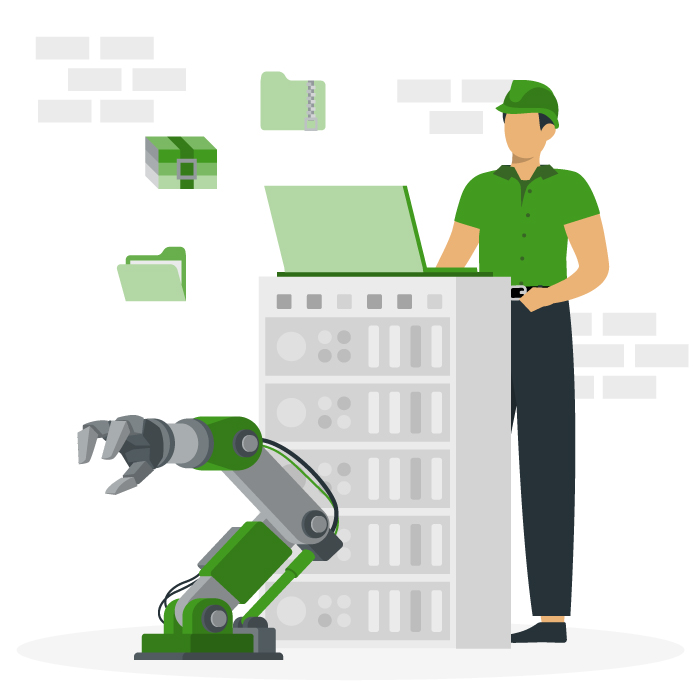Equipment Redundancy
Everything you ever needed to know about equipment redundancy.
What is equipment redundancy?
Equipment redundancy is a reliability engineering technique that helps a system to perform without interruption even when a piece of equipment fails.
Imagine two identical machines working simultaneously, sharing the load. Both machines are ready to take over the complete load in the event their counterpart fails. This ensures that there is no visible disruption in the operation even if one of them suddenly stops working.
Equipment redundancy is used across many industries, especially those that have high availability and reliability requirements:
Manufacturing example
In cooling systems, two compressors of the same specifications are run simultaneously where one would have been sufficient. This ensures that at least one compressor is functional at all times. Since the compressors share the load, their useful life is also prolonged.
IT example
In computing architecture, the same data is stored in multiple locations. When one of the locations goes offline, the data will be available from the other location. The data is constantly synchronized across locations. This geographical system redundancy ensures data is available round the clock. IT applications and other resources are also replicated at different locations for redundancy, not just data.
Automotive example
The tail light assembly for cars and most other automobiles have two sets of brake lights. One brake light is sufficient to inform other motorists that the automobile will be slowing down. But there are two sets to ensure that at least one brake light functions when the other fails.
Airline example
Twin-engine airplanes have redundant engines. In the event one of the engines fails, the other engine is powerful enough to safely land the aircraft at the nearest airport.
CMMS Buyer's Guide
Learn the questions to ask and the features to look for during the CMMS selection process - and find the right CMMS for you.

What does ‘fully redundant’ mean?
When equipment or system is replicated completely and both run in parallel, we can say that the system is fully redundant.
Consider an industrial application that requires 2000 W of electrical power that has to be supplied using a Power Supply Unit (PSU). When two PSUs, both with 2000 W power capacity, are used – and each delivers 1000 W – the system is fully redundant.
The main unit and the redundant unit are identical in all aspects and share the load equally when both are functional. When one of the PSUs fails, the other will be able to deliver the complete requirement of 2000 W.
Some systems might even run three (triple modular redundancy) or even four units (quadruple modular redundancy) to be extra safe. As you can imagine, that is very rare as it triples or quadruples your system’s costs.
The difference between standby, backup, and redundant equipment
Standby, backup, and redundancy may sound similar. There is a reason for that. All three are ways to improve system reliability. In all three modes, extra units of equipment are available to take over after equipment failure.
The differences are found in their operational configurations:
- Redundant equipment is operational along with the main duty equipment. They share the load, and when one fails, the other takes over the full load.
- Standby equipment is also ready to take over the operations of the main equipment the moment it fails. However, it is not operational alongside the main equipment. It turns on to take over the load once it gets the information that the main piece failed.
Backup equipment is not readily available as redundant or standby equipment. When the main equipment fails, the backup equipment has to be brought into operation (it sits in your warehouse as a spare). Even with a very fast response from the maintenance team, this is bound to cause a short delay.
Pros and cons of equipment redundancy
Redundant equipment is not a silver bullet. While it might sound great on paper, equipment redundancy comes with some very real drawbacks.
Pros:
- Higher equipment uptime and reliability: Equipment redundancy ensures near 100% uptime for our facility where it is implemented. In some cases, there are no other ways to achieve that.
- Less strain on maintenance: Maintenance is easier with equipment redundancy as the team is not under pressure to respond to the failure immediately. Additionally, when performing scheduled maintenance, the redundant equipment can be taken offline without affecting process continuity.
- Simplified reliability: Reliability engineering uses many complex techniques to improve equipment reliability. Equipment redundancy is the most straightforward way to improve the reliability and resilience of critical systems.
Cons:
- Capital expenditure: Since you are effectively buying two pieces of equipment instead of one, you capital expenditure is doubled.
- Operational complexity: Though equipment redundancy is the easiest way to increase reliability, it can be more complex to install and operate compared to a single-equipment system.
- Complacency: Equipment redundancy brings about a false sense of security which can make plant and maintenance employees complacent. They might take less responsibility for operating and maintaining redundant equipment.
Testing: You have to periodically test equipment redundancy by taking one of the devices offline. This makes sure the system is capable of handling any stress it is designed for – but eats up a little bit of your maintenance resources.
Should you purchase and install redundant equipment?
In most implementations, equipment redundancy is used to support critical equipment whose failure is likely to cause a safety hazard or substantial profit losses – and often causes both.
Here are some factors to keep in mind while determining when to opt for equipment redundancy:
- Uptime: The desired uptime is an important factor in determining the level of redundancy required in a system. If the system needs to have 100% uptime, then it has to be fully redundant.
- Critical equipment: All equipment in an operation is not critical, and therefore doesn’t need to perform the same. Critical equipment needs redundancy, while ancillary equipment can operate without it. This will reduce the number of equipment that needs redundancy, reducing complexity and cost.
- Failure rate: The failure rate of each piece of equipment is also an important factor. Equipment with high failure rates can benefit from redundancy.
- Cost: Equipment redundancy is a costly affair and the benefits you get are not always worth the investment.
When there are no safety considerations, as the last bullet point implies, your decision will come down to economic factors.
Want to see Limble in action? Get started for free today!
More is (not) always better
Equipment redundancy is a proven way to improve system reliability and resilience. But it comes at a cost, both in terms of capital expenditure and increased ongoing maintenance costs.
Regardless of whether you use redundant equipment or not, you will need a way to proactively maintain your physical assets. The easiest way to stay on top of your maintenance resources and schedules is to implement a mobile CMMS app like Limble.


